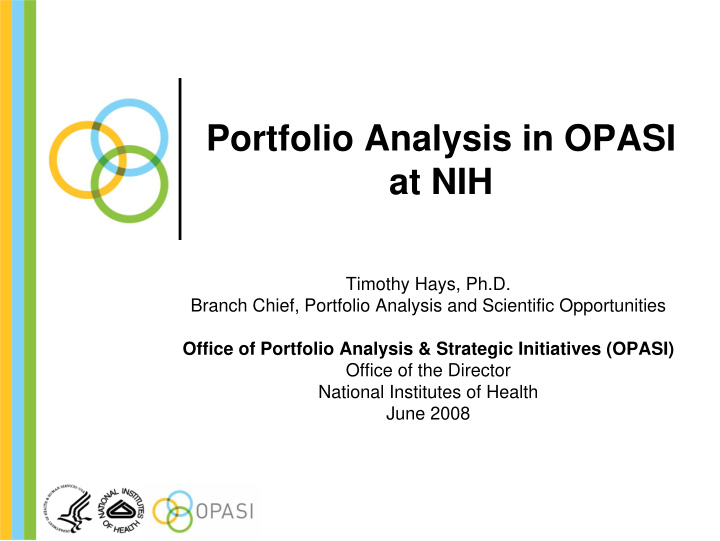



Portfolio Analysis in OPASI at NIH Timothy Hays, Ph.D. Branch Chief, Portfolio Analysis and Scientific Opportunities Office of Portfolio Analysis & Strategic Initiatives (OPASI) Office of the Director National Institutes of Health June 2008
Portfolio Analysis in OPASI � Analyses of the NIH research portfolio (Intramural and Extramural) in all its dimensions � Enhance the evaluation and management of the large and complex NIH scientific portfolio • Facilitate trans-NIH scientific planning and priority-setting initiatives • Support the ICs in their own planning processes • Gap and overlap analyses of research (within and outside of NIH) • Identify opportunities to invest in new areas of research • Explore return on scientific investment 2
Evaluating the Full Research Portfolio Connecting the “dots” to evaluate a field NIH Projects Patents Field of Science Other Research Funding Groups Research Publications NIH Application Submissions 3
Portfolio Analysis for Evaluation Enhancing evaluation through portfolio analysis – First: What is the question we are trying to answer? Second: Choose the tool(s) and data set (s) best able to answer the question. Questions: • What is the state of the science? • Are there gaps in our research portfolio? – How do the gaps compare to research carried out in other agencies? • How much do we spend on mitochondrial research? • What is the average number of scientific papers generated per $100K spent per grant? 4
Portfolio Analysis for Evaluation Enhancing evaluation through portfolio analysis – � Exploring funded NIH projects • Funding rates among ICs • Analysis of scientific content of projects � Understanding unfunded NIH grant submissions • Are emerging theories or innovation left unfunded? � Evaluation of progress and/or future directions • Return on investment • Identify most promising avenues for future investment 5
Portfolio Analysis for Evaluation Tools for Identifying and Evaluating NIH Projects - examples • Research, Condition, and Disease Categorization (OD/NIH) – Mining projects for scientific content � Extramural, intramural, contracts • e-SPA – Electronic Scientific Portfolio Assistant (NIAID/NIH) – Linking projects and portfolios to research outcome indicators • QVR – Query, View and Report (CIT/NIH) • Spires (NIEHS/NIH) – Publications listings associated with NIH funded projects and also RCDC categories 6
Portfolio Analysis with RCDC RCDC – understanding NIH funded research projects using the scientific content � Fingerprint – scientific concepts from the thesaurus � Research Project Fingerprint (weighted list of concepts) � Category Definition Fingerprint (weighted list of concepts) � Matching process to see what projects match the categories 7
Portfolio Analysis with e-SPA NIAID’s Electronic Scientific Portfolio Assistant (e-SPA) – connecting the entire NIAID portfolio 8
QVR/SPIRES – links publications to 9 NIH Grants database
Projects in Cancer and Depression 10
11 Publications linked to NIH Grant: R01 MH051947
Portfolio Analysis for Evaluation Evaluation of progress and/or future directions � Explore return on investment: • Publications and Patents • Research Resources: Advances in Tools, Analytics, Methodologies, Biologics, etc. • Medical Discoveries, Devices, Treatments, CURES… � Identify promising avenues for future investment • Gap and overlap analysis – Using visualization tools – Looking at the wider portfolio – beyond NIH 12
Comprehensive Portfolio Analysis Looking for Gaps and Overlaps in the Wider Portfolio � The Literature • PubMed • Web of Science • Biological abstracts – a source of more current of information than publications � Portfolios of other Funding Agencies • Federal agencies • Private non-profits sponsors 13
Analyzing Portfolio Data � Tools for Mining Scientific Content • PubMed tools • Other text mining tools • IN-SPIRE – text mining and clustering • Heat maps 14
Analyzing Portfolio Data Visualizing data with IN-SPIRE™ to facilitate the analysis of patterns – giving insight into gaps 15
Visualization – Heat Map Provides a high level visual overview of the changes with NIH RCDC Category information over time smallest value same largest value 16
Portfolio Reporting to the Public Office of Extramural Research (OER) Research Portfolio Online Reporting Tool (RePORT): http://report.nih.gov/ 17
Portfolio Analysis and Evaluation � Conclusions – comprehensive analyses of the scientific content of research portfolios affords powerful means for evaluating and managing complex research portfolios � Questions • How are you analyzing your research portfolios? • What are the opportunities for cross-federal analyses? • Are there opportunities to share data? 18
Recommend
More recommend